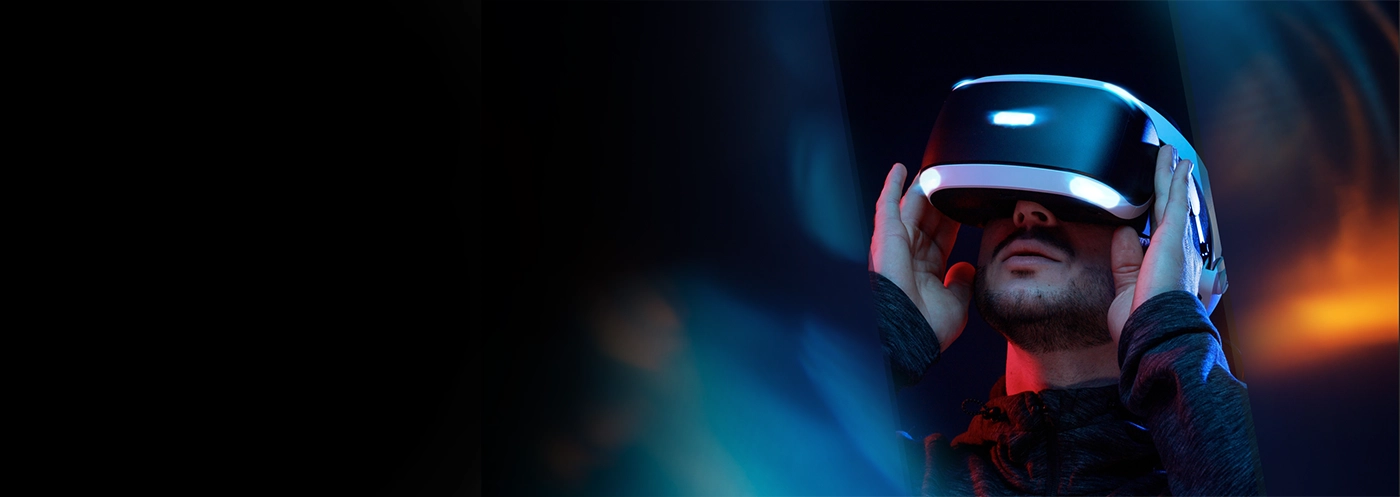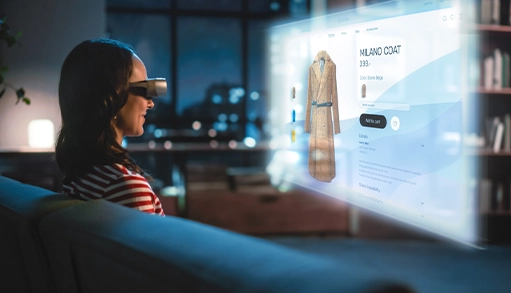
AR and VR in UX: A Transformation of Digital Interfaces
 Krishnan Ramachandran
Krishnan RamachandranLead, UX

In the ever-evolving landscape of technology, two concepts have recently gained prominence: Augmented Reality and Virtual Reality. These immersive technologies are not only transforming the way we interact with computer interfaces, but also influencing industries across the board. At Reflections, we have seamlessly aligned with the transformational impact of AR and VR on UX and their applications in various domains.
In the ever-evolving landscape of technology, two concepts have recently gained prominence: Augmented Reality (AR) and Virtual Reality (VR). These immersive technologies are not only transforming the way we interact with computer interfaces, but also influencing industries across the board. In this blog, we discuss how AR and VR are transforming user experiences (UX) and their applications in several fields.
The Impact of AR and VR on UX
Immersive Engagement
Augmented and virtual reality provide users with an unparalleled sense of immersion. For instance, virtual reality transports users into fully digital environments, enabling interactions with their surroundings in ways previously unimaginable. This enhanced immersion facilitates a stronger bond between users and digital content. From a user experience standpoint, this results in more captivating and compelling user interactions. Companies can harness this immersive feature to craft lasting and impactful engagements with their customers.
Real-World Integration
Augmented Reality presents an innovative method by smoothly merging digital elements with the physical world. This fusion can take the form of data overlays on a mobile device screen, exemplified by applications such as Google Maps, or materialize in location-based gaming experiences like Pokémon Go. Augmented Reality’s capacity to deliver context-sensitive information adds depth to our comprehension of the actual environment, establishing it as a potent tool for improving user experiences. Users gain access to information directly relating to their present surroundings, heightening the functionality and usefulness of this technology.
Spatial Interaction
Spatial interaction represents a compelling aspect of AR and VR. These technologies empower users to interact with computer interfaces using gestures, tracking their gaze, and recognizing spatial cues. This spatial component adds an extra dimension to user engagement, rendering interactions more instinctive and organic. For companies, this implies that UX can be improved by providing interactive and instinctual controls, resulting in a more seamless and enjoyable user experience.
Personalization
AR and VR hold the potential to transform the idea of personalization. These technologies can adjust content based on a user’s actions, preferences, and physical location, yielding an incredibly personalized and pertinent UX. This degree of personalization can result in more captivating and fulfilling experiences for users. For companies, this personalization opens the door to tailoring content and services to individual users, heightening user loyalty and overall satisfaction.
In summary, AR and VR technologies have had a significant impact on UX by providing unmatched immersion, improving integration with the real world, introducing spatial interaction, and enabling personalization. Businesses that effectively utilize these technologies can generate more captivating, interactive, and tailored experiences for their users, ultimately leading to greater user satisfaction and loyalty.
Applications in Different Industries
Gaming
Virtual reality has brought forth a new era for the gaming sector. Players can now completely submerge themselves in entirely digital realms, going beyond the confines of conventional gaming. VR headsets and controllers allow gamers not only to engage with the game but also to experience as if they are an integral part of it. For example, games like Half-Life: Alyx offer an immersive VR experience, allowing players to physically interact with their environment, creating a more captivating and lifelike gaming adventure.
Education
The field of education is getting transformed by the immersive and interactive learning opportunities VR is offering students. They can go on virtual excursions to historical locations, delve into the intricacies of the human body in three dimensions, understand mechanics in 3D, and carry out chemical experiments in a secure, digital environment. An example is the zSpace app, which offers virtual trips to various educational locations, bringing subjects to life and making learning engaging and memorable.
Healthcare
In the healthcare domain, AR and VR are proving to be beneficial tools. Surgeons can hone their expertise by practicing intricate procedures in virtual settings before applying them to actual patients, thereby enhancing their abilities and diminishing potential risks. VR therapy offers comfort to patients receiving treatment, while AR glasses empower physicians to access up-to-the-minute patient information during procedures, elevating the precision of diagnosis and treatment. For instance, companies like Augmedics offer virtual surgical training, ensuring that healthcare professionals are well-prepared for complex surgeries.
Retail
Augmented Reality is reshaping the retail industry by enhancing the shopping experience. Customers can use their smartphones to visualize how furniture might look in their living spaces or virtually try on clothing items before making a purchase decision. This ‘try-before-you-buy’ approach not only enriches the shopping experience but also reduces the likelihood of product returns. For instance, IKEA’s AR allows customers to place virtual furniture in their homes to assess its fit and appearance before making a purchasing choice.
Architecture and Design
AR and VR technologies serve as indispensable assets for architects and designers. These tools allow experts to see their designs in three dimensions, simplifying the communication of their concepts and the detection of potential problems prior to the commencement of construction. This form of visualization is reshaping the way projects are strategized and carried out. For example, companies like Unity Reflect offer tools that allow architects and designers to view their 3D models in real time, facilitating collaboration and improving project efficiency.
Summary
In summary, VR and AR technologies are instigating significant changes across multiple sectors, elevating user experiences, facilitating immersive education, enhancing medical training, enriching the retail environment, and reshaping the approaches of architects and designers in project development. These advancements not only boost user contentment but also introduce fresh pathways for creativity and efficiency within each of these domains. At Reflections, we successfully drive the transformation of our customers’ business and we have seamlessly aligned with the transformational impact of AR and VR on UX and their applications in various domains.
While discussing the transformational impact that AR and VR have, it is important to take note of the various concerns and challenges that these technologies bring in and the ways to deal with them. In the second part of this blog, we will explore the challenges at hand, best practices, and examine in detail how Reflections is integrating this technology to serve diverse clientele.
Author:
Krishnan Ramachandran, Lead, UX